Information Research
Special Issue: Proceedings of the 15th ISIC - The Information Behaviour Conference, Aalborg, Denmark, August 26-29, 2024
COVID-19 information spaces, boundaries, and information sharing: an interview study
DOI: https://doi.org/10.47989/ir292845
Abstract
Introduction. The goal of this paper is to understand who shares information used by the general public about COVID-19 and how they decided what information to share.
Method. Our qualitative work is based on semi-structured interviews conducted from April 2022 through December 2023 with 23 people who have provided COVID- 19 information through paid and volunteer roles. We used the critical incident technique. We also asked participants about their information gathering and credibility checking processes; their role in spreading information; and their typical audience for sharing.
Analysis. We transcribed interviews and conducted thematic analysis in MAXQDA software.
Results. We conceptualise the information space as consisting of the audience, communities, sharers, and experts. We illustrate three distinct exemplars of sharers. We describe how personal and historical experiences create boundaries around individuals (sharers and audience), which determine what sources of information are trustworthy, and how our participants share the information with their audience.
Conclusion. For COVID-19 information, the audience may be identified first or the information service may be formed first. Fact-checkers and science journalists’ job is to report truthful and verified information, and they do not tailor it to a specific community as much as people-centered sharers, such as patient advocates.
Introduction
The goal of this paper is to understand how scientific and technical information is shared in the current era, on a health-related topic of critical, and often personal, importance to the public. The term COVID-19 was coined in February 2020, several months after the detection of a novel coronavirus, and formally declared by the World Health Organization (WHO) as a public health emergency of international concern from January 30, 2020 through May 5, 2023 (WHO, 5 May 2023). At the very end of this period and in the following 7 months, we interviewed people who had shared information about COVID-19.
Our initial goal was to understand who shares information used by the general public, in order to develop resources that help public libraries support information sharing. In recruiting interviewees we first used the term knowledge broker (Canadian Health Services Research Foundation, 2003; Meyer, 2010), which refers to ‘people whose job it is to move knowledge around and create connections between researchers and their various audiences’ (Meyer, 2010). We drew on related concepts such as boundary spanners and gatekeepers (Haas, 2015). As we sought to understand what kinds of people might share information, we broadened the definition to consider sharers who have provided COVID-19 information.
Our research questions are: For individuals regularly sharing information, how did they gather and share information about COVID-19? How did they decide what information was trustworthy and worth sharing?
The remainder of the paper presents previous research, our methods, results, limitations, future work, and conclusions.
Previous research
Information seeking and acquisition can be explained by the sense-making theory and methodology developed by Brenda Dervin (Dervin, 1992). When faced with a problem, or a knowledge gap, people seek information to bridge that gap. However, according to sense-making theory, this new information is not a static phenomenon, but rather is constructed based on the personal and environmental context of an individual (Dervin, 1992). Dervin suggests that people make sense of the knowledge or information they receive by personalising their understanding to fit their own current time and place (Dervin, 1983). A sense-making or learning process ‘requires continuous dialogue, querying previous interpretations and beliefs to make sense of experience’ (Urquhart and Lam, 2021, p. 125): an individual revisits previously acquired information with new experiences that add new perspective to that information.
People are predisposed to seek and mistrust information based on their ideology (Marwick, 2018; boyd, 2018) and motivated reasoning (Kunda, 1990; Wojtowicz et al., 2022). What information is worth sharing is determined by structural social access: Who is in a position to interact with information across networks and between communities and influence what information is relayed between groups (Gould and Fernandez, 1989). Sharing may be possible due to a sharer’s proximity to a location, expertise in a domain or membership in a group (Starbird et al., 2010).
People rely on cognitive authorities when their own personal experience does not suffice (Wilson, 1983). For instance, gatekeepers rely on interpersonal communication with trusted partners to meet their everyday information needs (Agada, 1999). People actively judge and compare information, escalating from ‘convenient everyday sources’ to more authoritative ones; comparing multiple expert opinions; and verifying expert sources against ‘nonexpert sources…[with] cognitive authority’ (Greyson, 2018, p. 873). Personal authority, driven by testimony of lived experience, is particularly common online (Doty, 2015). Online content creators signal credibility based on their conception of their audience’s expectations, such as community building, expertise provision, synthesis of multiple perspectives, or filtering and compiling information (Rieh et al. 2014). Content creators may share information without explicitly confirming it; their credibility judgements combine intuitive, heuristic, and strategy-based approaches (e.g., cross-checking and using primary sources) (St. Jean et al., 2011). Content creators’ direct interactions with the audience post-production, can be valuable additions to creating unique, honest, balanced content that cites its sources (St. Jean et al., 2011).
Online information sharing is subject to a power law distribution: many accounts with few followers and little attention, who may reach larger audiences over time when discovered by those with more followers (Hemsley, 2018). Average users can become misinformed through platform-specific affordances that may lead them to misinterpret the meaning of what they see when doing their own research online, for example, when extracting meaning from Google results (Tripodi et al., 2023). Filtering information may involve ignoring low quality content (Kozyreva et al., 2023). People judge credibility in part based on who shared information (Tully et al., 2022). Mistrust of who controls fact checking can give rise to political backlash (Marwick, 2018) and scepticism (Brandtzaeg et al, 2018). With context collapse, information shared in a specific context reaches unintended audiences (Frost-Arnold, 2021; Marwick and boyd, 2011).
Online infrastructures for sharing information include Wikipedia and Q&A websites. To find references, Wikipedia editors use search engines, library resources, and existing references used in Wikipedia (Kaffee and Elsahar, 2021). Editors of Swedish Wikipedia assess credibility with cognitive authorities (cf. Wilson, 1983) such as the authority of authors and sources and by synthesising and comparing across sources (Francke and Sundin, 2010). The health sciences also draw from social infrastructures of knowledge (Long et al., 2013) through online patient communities that create and redistribute knowledge (Kazmer et al., 2014). Social Q&A websites (Bae and Yi, 2017) are often seen as a preferred source for first-hand information and narrative (Jeon and Rieh, 2013).
Methods
Our Institutional Research Board (IRB)-approved study conducted and analysed 23 semi-structured interviews with people who reported sharing credible or verified COVID-19 information on a regular basis. Interviews were conducted in English from April 2022 through December 2023 in online video calls using Zoom. For our research information sheet and interview questions see Appendix I.
Participant recruitment
At the beginning of the project, in an attempt to define the subjects of our study, we focused our recruitment on people who share information as part of a paid or volunteer occupation. We aimed to recruit journalists, activists who aimed to encourage social actions to address issues related to COVID-19, and Wikipedia editors. For activists and journalists, we looked for Twitter (now X) accounts that shared scientific and technical information on COVID-19 using hashtags such as #COVID19, #COVIDvaccine, and #masking, and people mentioned in or authoring news on COVID-19-related topics. We contacted individual activists and patient advocacy organisations via email or direct messages on their social media platforms. As our conceptualisation of sharer evolved, we expanded our recruitment to anyone who shared COVID-19 information on a regular basis, such as through social media posts and one-on-one conversations. To reach a wider pool of potential participants, we created posts on Reddit.com. Further details of our recruiting are described in Appendix II.
Data collection
Interviews used the critical incident technique (Flanagan, 1954). First, we prompted participants to recall a specific incident in which they were gathering information. Then we asked them to describe their process. We asked questions such as:
What does the process of gathering information look like for you?
What types of information did you look for?
How did you know a source was credible?
How did you see your role in spreading information?
Who is your typical audience?
Our interview questions were focused on the information sharing process and credibility ensuring practices. Semi-structured interviews enabled rich detail and flexibility. However, their time-consuming nature makes the recruitment process difficult. We told prospective participants to plan on an hour. Most interviews lasted between 55-70 minutes (min 33 minutes, max 105 minutes). To focus on what seemed salient, the interviewer asked follow-up questions, and participants elaborated on the context of their interactions with their sources and audiences and the details of their information seeking and sharing behaviour. However, when an interview is not fully structured, the interviewer may ask leading questions that may bias participants’ responses.
Of our 23 participants whose data was analysed for this study:
16 were located in the United States. 7 were located in Brazil (2), France (1), India (1), South Africa (1), Tunisia (1), and Sweden (1).
14 have formal training or a degree: biology, biomedical science, communication, economics and law, education, engineering, law, medicine (2), psychology, public policy, science, science journalism, sociology.
8 told us about their COVID-19 information sharing as part of their professional career: patient advocate (4), science journalists (2), CEO of a pharmaceutical company (1), fact-checker (1).
15 identified as volunteers or sharing COVID-19 information as a side activity (including 5 Wikipedia editors).
They were recruited via email (12), Wikipedia (5), Reddit (6).
Data analysis
Coding and analysis was done by the first author. After transcribing interviews, she analysed them in MAXQDA (Release 22.8.0) using thematic analysis (Clarke and Braun, 2017). As the first author corrected automatically generated transcripts, she familiarised herself with the interview data. The coding process was highly iterative: we discovered a number of interesting patterns and features of data during the initial open coding, and further iterations helped to identify more consistent features and ideas across the interviews and revealed themes that were not immediately salient, for example, the distinction between information-centered and people-centered information sharers, which we discuss below. The flexibility that allowed our research questions and data interpretation to evolve through the iterative process is one of the benefits of the thematic analysis.
Results
COVID-19 information space
Our information space in Figure 1 emphasises an audience, communities, sharers, and experts.
Everyone is surrounded by COVID-19 information: they choose what information they trust. While they may share that information with others through an occasional social media post or conversation, in most respects they are the audience for others’ sharing.
Sharers process the information they receive and then share the processed information with their audiences. We format quotations from our interviews in italics with the sharer’s participant number, P1 to P23, below.
Communities may form based on the physical abilities of an audience to perceive information (P1: ‘Is this gonna be a good use of their limited energy?’) and/or the social, demographic and educational background of an audience (P9: ‘you have these cultural things that […] put pressure on you not to speak up.’).
Sharers contact experts or access experts’ work to verify information. Experts include domain experts, or renowned organisations and institutions that sharers choose to trust. Typical experts were medical researchers studying COVID-19 or people who have access to particular information due to their profession. For example, documentary-maker P8 consulted 20 embalmers ‘who were reporting an anomaly [blood clotting]’.
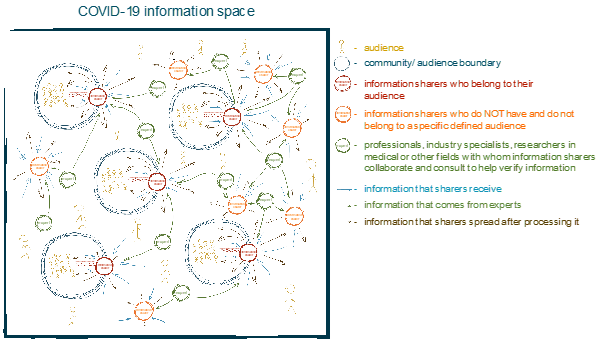
Figure 1. The COVID-19 information space includes sharers, communities, experts and audiences.
The information space describes the flow of all information on a specific topic. Whenever anyone uses COVID-19 information they become part of the COVID-19 information space, just by participating in the flow of information. Every audience member, every community, and every sharer is a part of this same information space, as are experts consulted for topic-relevant information. Notice that Figure 1 depicts multiple communities and multiple sharers, because while information can be tailored to certain communities, it is not restricted to a specific community. Rather, information reaches audiences beyond the targeted ones.
The sharers
What distinguishes our sharers from audience members at large is that they share COVID-19-related information on a regular basis. Sharers may start as audience members and then take up the role accidentally. For example, P4 became a COVID-19 expert by contracting the virus and learning more information about it through doctor’s office visits, before beginning to share the information: P4:
After I wrote my [mainstream news source] article, that’s when I started on Twitter, […] and as the stuff was coming out I just kind of kept pushing it out there, and so I would reach something, synthesise it. Tell the world about it. Now, surprisingly, I have like hundreds of doctors who follow me.
Most participants described sharing COVID-19-related information in multiple ways:
14 in one-on-one conversations
10 by sharing on social media such as Twitter (now X)
5 in Wikipedia and related Wikimedia projects
4 sharing information in an opinion piece
4 on websites of other types
4 via email distribution (newsletters)
3 in films or videos
2 in magazine or newspaper articles
2 in books or book chapters
2 via TV appearances
2 in presentations
1 in blogs
1 via texting
1 in town halls
1 in webinars
Sharers may only have a general idea of who their audience is (e.g., science journalist P6 described their audience as: interested in science): their audience comes across the information they share, reads it and moves on. Other sharers actively interact via constant conversation with the people who access the information they share. These sharers choose information that would be relevant for their community, then process and share that information in a way that respects their community’s interests and needs (P1, P5, P9, P10, P13). The information that they share may also be spread outside of their community (e.g., social media that is accessible to anyone on the Internet). Wikipedia networks and some audiences served by patient advocacy groups (e.g., P5 had been in HIV patient advocacy) were formed for a different purpose before the COVID-19 pandemic, and had existing tools and infrastructure that were later used for communicating COVID-19 information (P1, P5, P14, P15).
Sharers’ sources and who they trust
Sources of information for the sharers vary from news stories to personal anecdotes to scientific publications. Some participants described set routines that allow them to stay up to date on a certain topic. Other participants get exposed to new information as part of their daily lives and some actively look for more information.
Online tools, such as Google Alerts (P1, P2), PubMed (P1) alerts and news digests (P2) help to focus only on specific topics and save time. P11 even built their own bot ‘using Python to get all this information from these multiple sources and integrate them together.’
P7 dedicates time to read different publications every day, including academic articles: ‘On a daily basis, I read in excess of 30 different publications from across the spectrum, everything from partisan rants on both sides of the aisle to serious medical literature to papers published in peer-reviewed journals.’
The audience may also provide information to the sharer. For instance, P1, based at a COVID-19 and Long COVID advocacy group, says:
Another amazing source of information and kind of gold nuggets is the patient community themselves. We often get folks who just email us unsolicited insights that they said: ‘Hey’ I've been tracking this drug for years’ I've tried it myself, and I think it's a good potential, an’ I've tried it off label.’ And they’ll send us their case study notes and their own medical information and we treat that with the utmost respect, and we'd always try to divert them into the registry... But I've had patients outright send clips of hair and nail filing, ‘Please take this and use it for genetic research or something.’ They just send it in the mail, again unsolicited.
Some of the participants had had information sharing experiences in other or adjacent areas before COVID-19 pandemic started (P1, P2, P5, P6, P7, P9, P13, P14, P15, P16, P17). Some of the tools, skills and prior networks of collaborators that sharers had from previous experience were helpful in the COVID-19 case. P7 says:
I’ve got a system for that. […] It has been very valuable to have a PhD biostatistician that's been really responsive to me, because his field is so broad. Everything dealing with biology and statistics that he can almost always point me to somebody or something or lead me in the right direction.
P5 used their advocacy experience and knowledge about best practices for research on gender that's trans-inclusive.
P1 had developed a network of trusted sources: ‘I never cultivated this network of information influencers intentionally, with the purpose of trying to get information out there or receive information back. It was really organic, and it came from me trying to do my job.’
These sharers indicate that gathering and sharing information on COVID-19 pandemic was different from other topics they had worked on: P6: ‘The process is not different, but COVID was special due to just how fast everything changed and just how much we didn’t know.’ Participants found it more challenging due to the lack of peer-reviewed scientific sources and the fast pace with which new information was appearing on social media, news outlets and other forms of media at the beginning of the pandemic.
Wikipedia editors have defined guidelines regarding the acceptable sources of information: P15: ‘There is a strict policy for what’s considered a good reference. And there are some standards of quality that say that something can be trusted or not.’ P16: ‘On Wikipedia you basically need tertiary sources. Original research is not allowed. And then if possible, you should add systematic reviews and meta-analysis.’
Specific sharers’ information spaces
Our sharers each have their own information space. The three most popular ways our participants shared COVID-19 information are described in Figure 2: sharing based on personal experience; Figure 3: sharing as a patient advocate; and Figure 4: as a Wikimedia editor.
Sharing based on personal experience as an accidental COVID-19 expert
P4 described themself as an accidental COVID-19 expert. P4 got COVID-19 at the early stage of the pandemic, the first week of March 2020. Then, they remember, ‘every medical person, including Anthony Fauci’ was saying that ‘if you’ve had COVID, then you are not at serious risk of getting COVID again, and if you do, it's going to be very mild’. This information is represented by the first, most outer red circle around P4 in Figure 2, which shows how their information space developed over time.
The second circle (purple) around P4, came from an experience with medical malpractice for another disease. Then, after being successfully treated, when P4 asked if they should get vaccinated against that other disease, the new doctor strongly recommended against getting vaccinated because P4 already had antibodies – this is the third circle (dark yellow) around P4.
P4 concluded that information from the other disease applied to COVID-19: that they should not get vaccinated against COVID-19, ‘it's not just unnecessary, but it's dangerous’. While looking for more information, P4 found an immunologist on X (formerly Twitter) ‘saying, if you have natural immunity, don't get vaccinated. It's very dangerous […] because it could over-inflame your immune system’ and whose wife died due to medical malpractice. Thus, the next purple circle appears around P4: they meet someone who, like P4, has had a medical malpractice experience, and whose relative was P4’s acquaintance. This made P4 more inclined to trust the immunologist over ‘these guys who’ve never had COVID telling me I needed to get vaccinated’. The immunologist confirms what P4 had heard: the danger of getting vaccinated after having had a disease and that it’s also true for COVID-19, thus, the next dark yellow and red circles.
While reading more, listening to podcasts, and watching YouTube videos on natural immunity, P4 becomes surrounded with the information on the same topic: ‘Then, my Google feed started pushing me things that would be relevant to these questions’. Figure 2 shows how finding more information on natural immunity tightens the circles and thickens the borders around P4, so that eventually they don’t accept any information that doesn’t confirm the knowledge they have already acquired, represented by the existing circles.
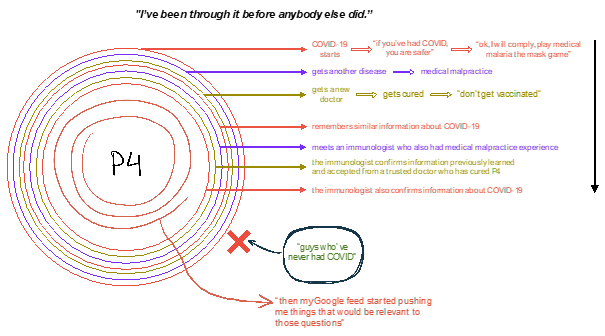
Figure 2. The COVID-19 information space of an accidental COVID-19 expert P4.
P4 contributes to the COVID-19 information space by sharing information through X (formerly Twitter) and casual one-on-one conversations with friends and family.
Community-centered activist
P9 is a community-centered activist sharing with a predominantly African-American community that includes other minoritised groups. When P9 searches for information on COVID-19, they specifically want to ensure that the information is relevant to their target audience. The samples in a lot of research and clinical trials that P9 finds don’t represent their target audience, and it is not clear how a certain study would apply to a specific group: ‘so I wonder, okay, is this another article [...] full of white patients only? Or is this a type of summary coming from a diverse pool of people?’
African-American communities are hesitant to trust scientific research due to the history of exploitation of the African-American population for scientific experiments: P9: ‘everyone’s oftentimes kind of stuck on this notion that they’re mad scientists out here who are collecting our information, they’re wanting to do experiments on us and all of that type of stuff’. Therefore, P9 needs to present scientific information in a way that will be accepted by their audience. P9 collects information that they assess as credible from government sources such as Centers for Disease Control (CDC), but they know that their audience will not trust that information if the audience knows the source of that information:
I try not to put information from the CDC. But I'll possibly state the information that I found there. But I won't say what the source is, particularly with the CDC because they have a very bad [reputation] in our community.
P9’s audience is more likely to believe the information they receive through a social route rather than the information that comes straight from a scientific or objective source.
Another consequence of distrust in the scientific process is that even African-Americans participating in research or getting vaccinated may not want others in their community to know about it, because family and friends may be judgmental and ‘say that say that you're a fool [...] for letting those people mess around with you’. This is shown in P9's information space, Figure 3, as individual boundaries (dark yellow) around each community member. Such prejudice not only reduces the participation of marginalised communities in research, thus limiting the resources and studies reflective of those communities, but also prevents marginalised patients from receiving necessary support when they get COVID-19. P9 hears personal stories from individuals in their community about the negative attitude they have received at doctor’s visits:
I can take their real life experiences and apply that and take that back to organisations that I consult and work with as a patient rep to give them an idea of basically what the pulse is and the community among a particular group of patients.
P9 also works with other organisations that want to share information and want to get P9’s feedback on how these organisations’ materials will be perceived in P9’s community. For example, P9 mentioned an ad company who wanted to get perspectives of patients from marginalised communities. P9 gave feedback on how likely their community members would be ‘receptive to the messaging based on the format that they were sharing’.
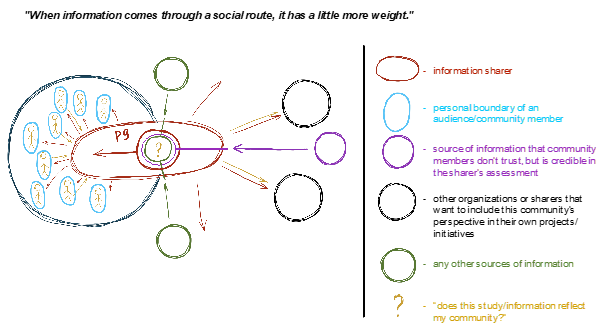
Figure 3. The COVID-19 information space of community-centered activist P9.
Wikimedian
P16 is a Wikimedian and medical researcher. WikiProject COVID-19 is ‘an affinity group for contributors with shared goals within the Wikimedia movement’ (WikiProject, 2024) ‘dedicated to Wikipedia’s coverage of the SARS-CoV-2 virus, COVID-19, and the COVID-19 pandemic’ (Wikipedia, 2023). Wikimedians contribute to the WikiProject COVID-19 by adding new Wikipedia articles and editing existing ones. They may coordinate with each other through a messaging app such as Telegram or WhatsApp.
P16:
If I had a question related to evidence about something or related to getting an image about something or getting the statistics updated on some page, I could put that in the Telegram group, and somebody would do that. [...] So, I didn’t really choose whom to contact. I just put the question out there in the open and whoever is ready would just take up that question and help me around.
Once Wikimedians publish or edit Wikipedia pages, that information is distributed to anyone with access to Wikipedia.
P16 is also an academic, a researcher in the medical field; this allows P16 to access some academic journals that have a paywall: ‘I could basically sit at my home and use these resources to, you know, build up articles from scratch’.
P16 doesn’t get feedback from the readers of the Wikipedia articles they wrote or edited. However, P16’s family and friends know that P16 does research in medicine and is a Wikipedia editor, so they contact P16 with medical questions about COVID-19:
they consider me as an authority in health care because I've got a PhD and I am a practising doctor, so they believe me when they hear from me. [...] I also try to make [...]complex scientific details a little bit more simple and try to explain to them the actual reason and in that case they probably understand and follow my advice.
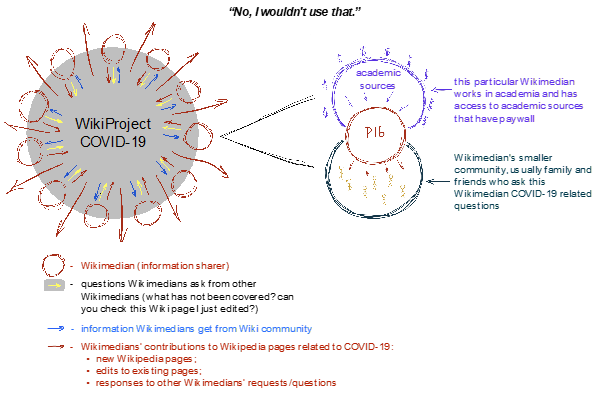
Figure 4. The COVID-19 information space of Wikipedia editor and medical researcher P16.
Comparing the three information spaces
We want to highlight the similarities in how these three information spaces are shaped, what information gets distributed and how.
P4’s personal experience had a strong influence. Being the first person who I knew got [COVID] gave them a level of authority with first-hand knowledge that was particularly unique early in the pandemic. This experience also determines who P4 trusts:
don’t trust a doctor who left you worse off;
trust a doctor who has proved their competence with actions by curing P4 from a different serious disease;
trust an immunologist who has a similar experience.
All of these people and events align with P4’s conviction not to get vaccinated after having COVID- 19.
P4 is not attached to a particular community or audience for which they target and tailor the information they share, therefore they would be represented by one of the sharers in the orange colour in the COVID-19 information space (Figure 1). P4 would identify with people with whom they have a common experience (e.g., having had COVID), but only to distinguish between what information can be trusted and what information doesn’t have enough credibility.
P4 invested a lot in researching COVID-19 and vaccinations: ‘I've thought about this a lot. And I've thought about this in my mind as a life-or-death issue because I've had COVID, I've been through it before anybody else did.’ This builds a personal boundary around P4 that determines what information is accepted within that boundary, and consequently what information is shared by P4 further.
P9 is part of a community with a common historical experience that has created a personal boundary around each of its members. Members of their community trust P9 as someone who understands their experience on a personal level, and they trust that P9 doesn’t have an intention to harm their community. P9’s motivation for sharing information is
not just to give information, it's not just to break it down, but it's really so that each individual can feel more empowered to make a decision that's based on truth and not on a legend, not on myth, not on past bias and experiences.
P9, knowing these personal boundaries and biases in their community, presents information from government sources without naming the source, because P9 knows that their audience would not accept that information otherwise, even though P9 had ensured its credibility.
P16 represents Wikimedians who contribute to the WikiProject COVID-19. All of the Wikimedians we interviewed, except for one (P13), hold a doctoral degree or are enrolled in a graduate academic program; they didn’t mention being personally affected by COVID-19. P11 notes that contrary to a common belief that
Wikipedia and Wikidata are edited by people who have nothing to do with medicine and with data science, most of the people who contributed to WikiProject COVID-19 were specialised people. They had some training in data science.[…] And actually, there are many people that have had medical training, like myself, or even have been professors in universities teaching medicine. So actually, they are kind of knowledgeable people.
Wikimedians are also expected to follow Wikipedia’s rules for editing pages and adding references, as mentioned earlier. Therefore, P11, P13, P14, P15, P16, as Wikimedians are expected to separate their personal experience from the information they add to Wikipedia. P16: ‘stories from people - no, I wouldn’t use that because on Wikipedia you basically need tertiary sources’. Wikimedians seem to be restricted by external boundaries imposed by a third party rather than personal experience boundaries. P14 says:
Wikipedia is, in communications, what we call a tertiary platform. So, it’s an aggregator of references. So, if a reference is deemed reliable, [...] as a Wikimedian, we would normally just bring this information. If there is competing information, then we also add it. [...] That’s a Wikipedian ethos.
Motivations to share information: information-centered versus people-centered
All sharers we interviewed want to help their audiences and share accurate information, but have different motivations and priorities. Sharers in our study can be described, at the extremes, as information-centered or people-centered.
Information-centered sharer includes fact-checkers and journalists. Their priority is to find and present truthful information and in their information process, they strive to make sure that the information they share is as accurate as possible and they are open to being proven wrong themselves. Science journalist P6 notes: ‘I'm always happy to be proven wrong. If I've gotten something wrong, it's just best to do that before it gets published’.
Information-centered sharers do not identify with a specific community. They publish information on a website, newspaper or magazine (P6, P7, P14, P17) and don’t necessarily interact with whoever accesses that information. P14 says: ‘So one thing about being a Wikipedian is that you don’t know what people do with what you’ve written. But as I said, millions of people were going to Wikipedia for this information.’ Science journalists describe their audiences as nerdy adults (P6), ‘not necessarily scientists, but people who have some interest in this’ (P17). A fact-checker (P7) says they try to reach ‘everyone from eight-graders, PhD scholars, from journalists to voters, to parents, to children’.
In contrast, people-centered sharers, are motivated by a purpose of helping other people in their communities and often belong to those communities. They include people affected by COVID-19, patient advocates and Wikipedia editors. They either work for non-profit organisations or are volunteers. In other words, if there is any financial reward, it’s not their primary motivation to share information. Rather, these sharers spent most of the interview talking about their communities and people’s needs. They first recognise the need for accurate information in their community and then become sharers to satisfy that need by providing that information. P10: ‘We […] ultimately want to produce, develop vaccines for Africa and for low- and middle-income countries to empower them, to develop their own […] vaccines.’
P1 had set their infrastructure even before the pandemic started:
I say I am reluctantly an information influencer. I didn’t want to be but through my own work, building that bubble around me. It sort of became dumb to keep that bubble to myself, and I was helping other people.
P4, P5, P9, P12, P13, P21, P22 knew how COVID-19 can affect someone’s life from their personal experiences and wanted to help their communities to prevent contracting the disease or reduce the harm by providing information.
P12 lost one of their parents to COVID-19 and sees their role in spreading information as ‘doing my best to share accurate information about the COVID-19 pandemic, and then more specifically as it relates to people who’ve lost loved ones to COVID’.
A spectrum from Information-centered to people-centered
Wikimedians are in the middle of that spectrum. Their information sharing is guided by Wikipedia’s rules and guidelines, rather than helping a specific community, however, they care about helping the global community and their own community in the global context because ‘it was the right thing to do [...] You have a global situation affecting your community. You react immediately.’ (P14).
Implications for practice
Our study findings shed light on how and where people share information and what makes sharers trustworthy to their audiences. This knowledge can be used by libraries and other learning spaces when designing programs to facilitate a welcoming and inclusive environment for people from different backgrounds. Learning spaces can partner with information sharers to shape training programs and target communities that might otherwise feel uncomfortable seeking information in such spaces. Similar practices may be interesting to professionals working in community engagement and outreach, advertising, journalism, and related fields.
Our findings could also be used to help to design algorithms that allow new information to enter the online information space of each individual user. For example, recommendation systems can be helpful when a user wants to continue to find music similar to what they previously listened to. However, recommendation algorithms may prevent a user from accessing diverse points of view. Understanding how people select information and sources to trust can help in designing algorithms that facilitate exposure to diverse sources and viewpoints and more informed decision-making.
Limitations
Recruiting participants was difficult and idiosyncratic. This is not a representative sample yet its strength is its diversity. Our ideas of who can be a knowledge broker (later sharer) expanded as we spoke with interviewees. 22 of the 23 interviews were after WHO declared an end to the public health emergency of international concern and the first was just a few days before this declaration, which impacted the information immediately salient to interviewees. Interviews present self-reported data with an idealised version of information processing, such as describing their information as being vetted. Our positionality as university-based researchers in a formal IRB-approved study likely had an impact: People willing to talk about COVID-19 information with a research team may be more likely to have certain positions and information verification strategies.
Future work
In future work, embedded ethnographic methods could provide a valuable complement to observe the information sharing process, especially in teams or training situations in which processes and norms need to be articulated, and with positionalities that facilitate access to diverse parts of the information ecosystem. Computational and ethnographic methods could help illuminate interactions between sharers and the information ecosystem's network structures and algorithms. Our immediate future work will investigate (1) artificial intelligence and labour and (2) climate change; like COVID-19 these topics involve public controversies where citizens' understanding of scientific and technical information may impact public policy. We will continue to refine recruiting strategies and our conceptualisation of interviewees' relevance, beyond people who share topic-related information on a regular basis.
Conclusions
Everyone is surrounded by COVID-19 information, yet the sharers we spoke with had distinct COVID-19 information spaces. Experiences may be specific to an individual or to a group that shares a common history or culture; these create boundaries that determine what information an individual accepts and chooses to believe. Rules imposed by employers and by Wikimedia or determine how people share information and choose what sources to trust. Our study found that people sharing COVID-19 information on a regular basis have different ways of interacting with their audiences, directly or through a website. The audience may be identified first (as COVID-19 hit, reliable information about the novel coronavirus was in demand), such as advocacy organisations designed to serve a certain community; or the information service may be formed first, such as in blogs, microblogs, fact-checking sites, and news websites. Sharers have different motivations to gather and share information. Fact-checkers and science journalists’ job is to report truthful and verified information, and they do not tailor it to a specific community as much as people-centered sharers, such as patient advocates.
Acknowledgements
This research is funded by the United States Institute of Museum and Library Services RE-250162-OLS-21. Thanks to Allen Renear, Hannah Smith, Heng Zheng, Janaynne Carvalho do Amaral, Kyungwon Koh, Lev Frank, Liliana Giusti Serra, and Melissa Ocepek for providing feedback on a draft. Thanks to Lev Frank and Hannah Smith for discussions of the implications.
About the authors
Togzhan Seilkhanova is a PhD student in Information Sciences at the University of Illinois at Urbana-Champaign. togzhan2@illinois.edu
Theodore Dreyfus Ledford is a PhD student in Information Sciences at the University of Illinois at Urbana-Champaign. tledfo2@illinois.edu
Jodi Schneider is Associate Professor of Information Sciences at the University of Illinois at Urbana-Champaign. jodi@illinois.edu
References
Agada, J. (1999). Inner-city gatekeepers: An exploratory survey of their information use environment. Journal of the American Society for Information Science, 50(1), 74–85. https://doi.org/10.1002/(SICI)1097-4571(1999)50:1<74::AID-ASI9>3.0.CO;2-F
Bae, B. J., & Yi, Y. J. (2017). What answers do questioners want on social Q&A? User preferences of answers about STDs. Internet Research, 27(5), 1104–1121. https://doi.org/10.1108/IntR-08-2016-0245
boyd, danah. (2018, March 16). You think you want media literacy… do you? Data & Society: Points. https://medium.com/datasociety-points/you-think-you-want-media-literacy-do-you-7cad6af18ec2
Brandtzaeg, P. B., Følstad, A., & Chaparro Domínguez, M. Á. (2018). How journalists and social media users perceive online fact-checking and verification services. Journalism Practice, 12(9), 1109–1129. https://doi.org/10.1080/17512786.2017.1363657
Canadian Health Services Research Foundation. (2003). The theory and practice of knowledge brokering in Canada’s health system. Canadian Health Services Research Foundation. https://www.ktpathways.ca/resources/theory-and-practice-knowledge-brokering-canadas-health-system
Clarke, V., & Braun, V. (2017). Thematic analysis. The Journal of Positive Psychology, 12(3), 297–298. https://doi.org/10.1080/17439760.2016.1262613
Dervin, B. (1983). Information as a user construct: The relevance of perceived information needs to synthesis and interpretation. In S. A. Ward & L. J. Reed (Eds.), Knowledge Structure and Use: Implications for Synthesis and Interpretation (pp. 155-183). Temple University Press.
Dervin, B. (1992). From the mind’s eye of the user: The sense-making qualitative-quantitative methodology. In J. D. Glazier & R. R. Powell, Qualitative research in information management (Vol. 9, pp. 61–84). Libraries Unlimited. https://www.ideals.illinois.edu/items/2438/files/Dervin1992a.htm
Doty, C. (2015, March 15). Social epistemology and cognitive authority in online comments about vaccine safety. iConference 2015 Proceedings. https://hdl.handle.net/2142/73664
Flanagan, J. C. (1954). The critical incident technique. Psychological Bulletin, 51, 327–358. https://doi.org/10.1037/h0061470
Francke, H. & Sundin, O. (2010). An inside view: Credibility in Wikipedia from the perspective of editors. Information Research, 15(3). https://informationr.net/ir/15-3/colis7/colis702.html
Frost-Arnold, K. (2021). The epistemic dangers of context collapse online. In J. Lackey (Ed.), Applied Epistemology (1st ed., pp. 437–456). Oxford University Press. https://doi.org/10.1093/oso/9780198833659.003.0018
Gould, R. V., & Fernandez, R. M. (1989). Structures of mediation: A formal approach to brokerage in transaction networks. Sociological Methodology, 19, 89–126. https://doi.org/10.2307/270949
Greyson, D. (2018). Information triangulation: A complex and agentic everyday information practice. Journal of the Association for Information Science and Technology, 69(7), 869–878. https://doi.org/10.1002/asi.24012
Haas, A. (2015). Crowding at the frontier: Boundary spanners, gatekeepers and knowledge brokers. Journal of Knowledge Management, 19(5), 1029–1047. https://doi.org/10.1108/JKM-01-2015-0036
Hemsley, J. (2018). The role of middle-level gatekeepers in the propagation and longevity of misinformation. In B. G. Southwell, E. A. Thorson, & L. Sheble (Eds.), Misinformation and Mass Audiences (pp. 263–273). University of Texas Press. https://doi.org/10.7560/314555-017
Jeon, G. Y., & Rieh, S. Y. (2013). The value of social search: Seeking collective personal experience in social Q&A. Proceedings of the American Society for Information Science and Technology, 50(1), 1–10. https://doi.org/10.1002/meet.14505001067
Kaffee, L.-A., & Elsahar, H. (2021). References in Wikipedia: The editors’ perspective. Companion Proceedings of the Web Conference 2021, 535–538. https://doi.org/10.1145/3442442.3452337
Kazmer, M. M., Lustria, M. L. A., Cortese, J., Burnett, G., Kim, J.-H., Ma, J., & Frost, J. (2014). Distributed knowledge in an online patient support community: Authority and discovery. Journal of the Association for Information Science and Technology, 65(7), 1319–1334. https://doi.org/10.1002/asi.23064
Kozyreva, A., Wineburg, S., Lewandowsky, S., & Hertwig, R. (2023). Critical ignoring as a core competence for digital citizens. Current Directions in Psychological Science, 32(1), 81–88. https://doi.org/10.1177/09637214221121570
Kunda, Z. (1990). The case for motivated reasoning. Psychological Bulletin, 108(3), 480–498. https://doi.org/10.1037/0033-2909.108.3.480
Long, J. C., Cunningham, F. C., & Braithwaite, J. (2013). Bridges, brokers and boundary spanners in collaborative networks: A systematic review. BMC Health Services Research, 13(1), 158. https://doi.org/10.1186/1472-6963-13-158
Marwick, A. (2018). Why do people share fake news? A sociotechnical model of media effects. Georgetown Law Technology Review, 2(2), 474–512.
Marwick, A. E., & boyd, danah. (2011). I tweet honestly, I tweet passionately: Twitter users, context collapse, and the imagined audience. New Media & Society, 13(1), 114–133. https://doi.org/10.1177/1461444810365313
Meyer, M. (2010). The rise of the knowledge broker. Science Communication, 32(1), 118–127. https://doi.org/10.1177/1075547009359797
Rieh, S. Y., Jeon, G. Y., Yang, J. Y., & Lampe, C. (2014). Audience-aware credibility: From understanding audience to establishing credible blogs. Proceedings of the International AAAI Conference on Web and Social Media, 8, Article 1. https://doi.org/10.1609/icwsm.v8i1.14525
St. Jean, B., Rieh, S. Y., Yang, J. Y., & Kim, Y.-M. (2011). How content contributors assess and establish credibility on the web. Proceedings of the American Society for Information Science and Technology, 48(1), 1–11. https://doi.org/10.1002/meet.2011.14504801163
Starbird, K., Palen, L., Hughes, A. L., & Vieweg, S. (2010). Chatter on the red: What hazards threat reveals about the social life of microblogged information. Proceedings of the 2010 ACM Conference on Computer Supported Cooperative Work, 241–250. https://doi.org/10.1145/1718918.1718965
Tripodi, F. B., Garcia, L. C., & Marwick, A. E. (2023). ‘Do your own research’: Affordance activation and disinformation spread. Information, Communication & Society, 1–17. https://doi.org/10.1080/1369118X.2023.2245869
Tully, M., Maksl, A., Ashley, S., Vraga, E. K., & Craft, S. (2022). Defining and conceptualizing news literacy. Journalism, 23(8), 1589–1606. https://doi.org/10.1177/14648849211005888
Urquhart, C., & Lam, L. (2021). Supplementary and alternative methods: Dervin’s sense-making methodology. In Autoethnography for Librarians and Information Scientists. Routledge.
WHO. (2023, May 5). WHO Director-General’s opening remarks at the media briefing – 5 May 2023. World Health Organization. https://www.who.int/director-general/speeches/detail/who-director-general-s-opening-remarks-at-the-media-briefing---5-may-2023
Wikipedia:WikiProject COVID-19. (2023 Sept 28). In Wikipedia [Wikipedia coordination space]. https://en.wikipedia.org/w/index.php?title=Wikipedia:WikiProject_COVID-19&oldid=1177614416
WikiProject. (2024 Jan 8). In Wikipedia [main article space]. https://en.wikipedia.org/w/index.php?title=WikiProject&oldid=1194263852
Wilson, P. (1983). Second-hand knowledge: An inquiry into cognitive authority. Greenwood Press.
Wojtowicz, Z., Chater, N., & Loewenstein, G. (2022). The motivational processes of sense-making. In C. M. Wu, E. Schulz, & I. Cogliati Dezza (Eds.), The drive for knowledge: the science of human information seeking (pp. 3–30). Cambridge University Press. https://doi.org/10.1017/9781009026949.002
Appendix I
Our research information sheet: https://infoqualitylab.org/images/knowledgebrokers/knowledgebrokers-research-information-sheet.pdf
Sample interview questions: https://infoqualitylab.org/images/knowledgebrokers/knowledgebrokers-interview-questions.pdf
Appendix II
Phase 1: Email and website recruiting [April 2022 – November 2023]
a. Website call for participation:
https://infoqualitylab.org/projects/knowledgebrokers/participate-y1
(history via https://github.com/infoqualitylab/website
)
b. Interview invitation to prospective interviewee via email
Dear [***name***],
Would you be available for a one-hour via telephone or video conferencing interview, about how you assess the quality of technical and scientific information?
Our research project, funded by the Institute of Museum and Library Services, aims to understand how knowledge brokers assess the quality of technical and scientific information. We will use this to develop a toolkit of services for public libraries, to better serve both everyday citizens and knowledge brokers who help them get their information. To do this, we aim to speak to people about how they determine which scientific and technical information is reliable.
We would like to draw on your perspective as [***position***] and believe you are well positioned to represent the important perspectives of the [***community served***]. We would appreciate your response by [***date***]. The success of the project depends on the expertise and engagement of people like you. We would be honored to be able to include your voice.
Sincerely,
[***Name, enrollment manager***]
on behalf of
Jodi Schneider, PI, “Strengthening Public Libraries’ Information Literacy Services Through an Understanding of Knowledge Brokers’ Assessment of Technical and Scientific Information”
Assistant Professor
School of Information Sciences
University of Illinois at Urbana-Champaign
c. Invitation via social media direct message
Dear [***name***],
Would you be available for a one-hour via telephone or video conferencing interview, about how you assess the quality of technical and scientific information?
Our research project, funded by the Institute of Museum and Library Services, aims to understand how knowledge brokers assess the quality of technical and scientific information. We will use this to develop a toolkit of services for public libraries, to better serve both everyday citizens and knowledge brokers who help them get their information. To do this, we aim to speak to people about how they determine which scientific and technical information is reliable.
We would like to draw on your perspective as [***position***] and believe you are well positioned to represent the important perspectives of the [***field/industry***]. We would appreciate your response by [***date***]. The success of the project depends on the expertise and engagement of people like you. We would be honored to be able to include your voice.
Sincerely,
[***Name, enrollment manager***]
on behalf of
Dr. Jodi Schneider, PI “Understanding of Knowledge Brokers’ Assessment of Technical and Scientific Information.”
Assistant Professor
School of Information Sciences
University of Illinois at Urbana-Champaign
d. Interview invitation to organization via email
Dear [***name of organization***],
I am a researcher at the University of Illinois at Urbana-Champaign, seeking potential interviewees for our information science research.
Our research project, funded by the Institute of Museum and Library Services, aims to understand how knowledge brokers assess the quality of technical and scientific information and how they identify the need for sharing information. We will use this to develop a toolkit of services for public libraries, to better serve both everyday citizens and knowledge brokers who help them get their information. To do this, we aim to speak to people about how they determine which scientific and technical information is reliable.
We would like to speak with people who have provided information about COVID-19 to others.
More information about our research is available at:
https://infoqualitylab.org/projects/knowledgebrokers/
Below is a sample message you could share. Let me know if more information would be helpful. The success of the project depends on the expertise and engagement of people in your organization. We would be honored to be able to include their voices.
Sincerely,
[***Name, PhD student & Research Assistant***]
Would you be available for a one-hour via telephone or video interview about how you assess the quality of COVID-19-related information, for a research project at the University of Illinois at Urbana-Champaign?
Researchers at the University of Illinois seek to interview 40 people who have provided information about COVID-19. Interviews are about 1 hour, by phone or on a video platform such as Zoom. Interviewees will receive a $35 giftcard by email after the interview.
For more information, see
https://infoqualitylab.org/projects/knowledgebrokers/participate-y1
Sincerely,
[***Name, PhD student & Research Assistant, with signature line***]
on behalf of
Jodi Schneider, PI, “Strengthening Public Libraries’ Information Literacy Services Through an
Understanding of Knowledge Brokers’ Assessment of Technical and Scientific Information”
Associate Professor of Information Sciences
University of Illinois at Urbana-Champaign
Champaign, IL
https://ischool.illinois.edu/people/jodi-schneider
https://infoqualitylab.org/projects/knowledgebrokers/
Phase 2: Wikimedia-specific call [April 2023]
To reach Wikimedia editors, we created a Meta page [1] and call for
participation to WikiProject COVID-19 talk page on Wikidata [2].
[2]
Phase 3: Adding giftcards [IRB updated April 2023]
Participants received $35 gift cards upon completion of interviews. Initially, no compensation was offered for the interview participation. The recruitment process was challenging and slow, therefore, we decided to offer gift cards to stimulate participation and updated the IRB protocol in April 2023. The funds for the gift cards became available on the online platform we used for sending gift cards (tremendous.com) only in October 2023. We reached out to the previously interviewed asking if we could send them the gift cards for their participation. Only 7 out of 12 of those participants responded, one of whom declined the offer.
We added text to our recruiting indicating “Interviewees will receive a $35 giftcard by email after the interview.”
Phase 4: Reddit Recruiting [December 2023]
In December 2023, as our conceptualisation of sharer evolved, after updating our IRB protocol, we expanded our recruitment to anyone who shared COVID-19 information on a regular basis, such as through social media posts and one-on-one conversations.
To reach a wider pool of potential participants, we created posts on Reddit.com, specifically, “subreddits” dedicated to COVID-19 discussions: “r/ZeroCovidCommunity” and “r/LockdownSkepticism” [3]. Interested individuals were invited to complete a Qualtrics survey tool [b].
Survey respondents who shared information many times or on a regular basis (as opposed to once or just a few times) then received interview invitations. Between December 18 and December 28, 2023, we received 71 survey responses and selected 20 people based on how often they shared COIVD-19 information and how detailed their description of how they shared that information. Of those 20, 14 scheduled and completed an interview with us. Due to time constraints, in this paper we use the data from only 6 participants who responded to the Reddit post and scheduled the interviews on or before December 28, 2023. Excluded from this paper are the 8 interviews conducted from January 3, 2024 to January 12, 2024.
[3] Reddit recruiting post
Text of post:
Talk to library researchers about COVID-19 information sharing
Researchers at the University of Illinois Urbana-Champaign are seeking potential interviewees for library and information science research about sharing COVID-19 information. Interviewees will receive a $35 giftcard by email after the interview. Interviews are about 1 hour, by phone or on a video platform such as Zoom.
Have you provided information about COVID-19 to your community or social circle? This might be through one-on-one conversations, Reddit, social media, YouTube videos, podcasts, blogs, websites, artwork, Wikipedia, newspapers, how-to’s, advocacy, or in any other way. If so, we would like to speak with you!
Our research project, funded by the Institute of Museum and Library Services, aims to understand how adults connect around and use technical and scientific information. We want to know what kinds of information you share and how you determine whether it is reliable and relevant for your community or social circle.
For more information about our research and a survey to express interest in participating see:
https://infoqualitylab.org/projects/knowledgebrokers/participate-y1
[4] Qualtrics survey questions to ensure eligibility of participants recruited via Reddit
The survey screened by age (under 18) and location of China or Russia (due to our IRB legal requirements). We asked how often survey respondents shared information related to COVID-19 and by what means (in person or online). If a respondent reported sharing information online we asked for a link to the online content.
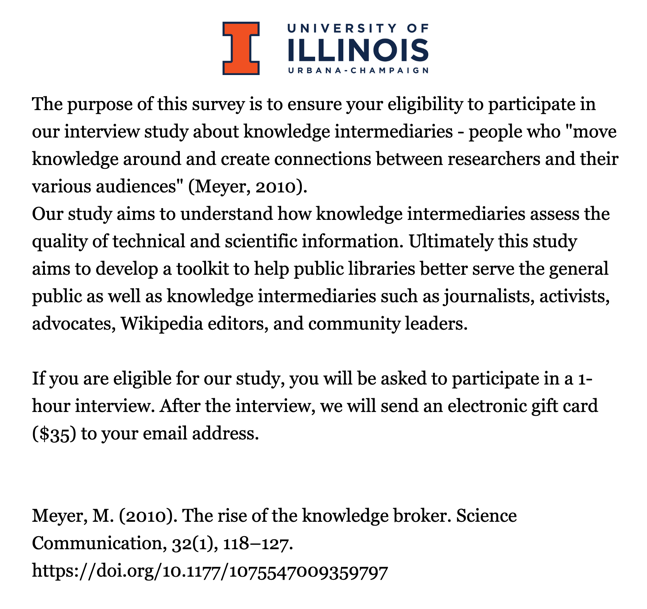 1.
1. |
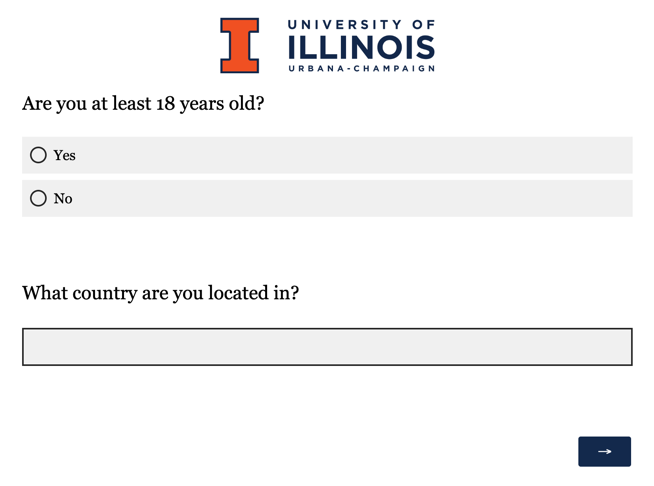 2. 2. |
|---|---|
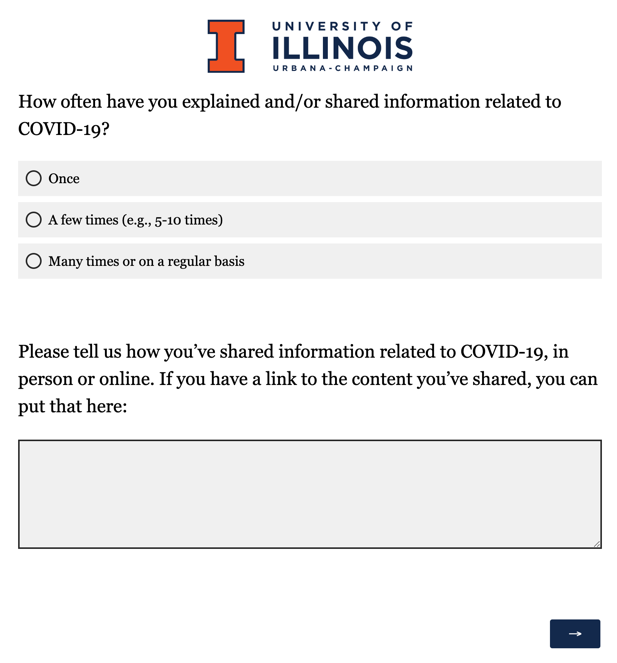 3. 3. |
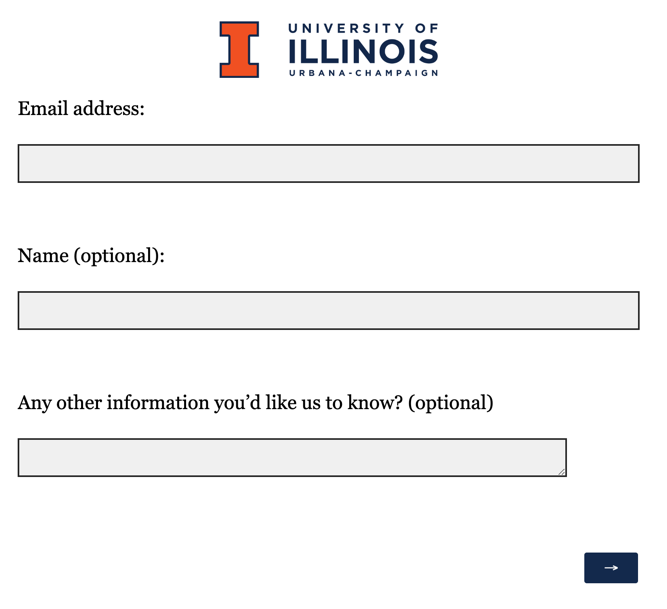 4. 4. |
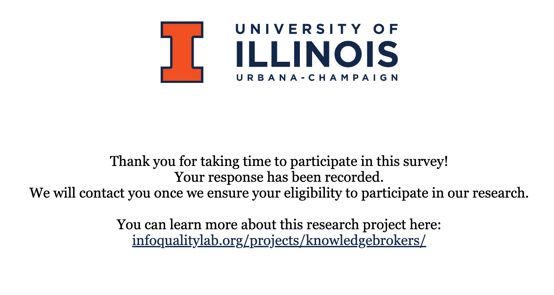 5. 5. |